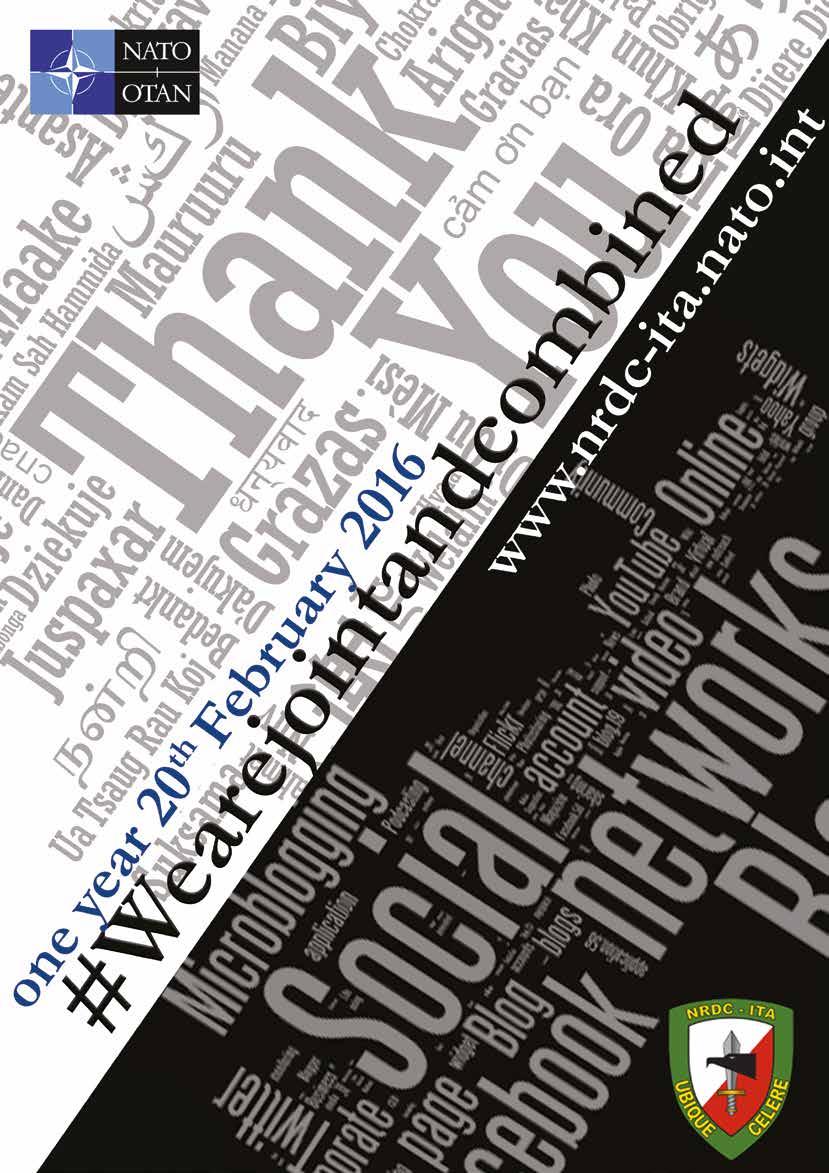




everywhere rapidly
Dear Reader,
This new issue of ER magazine marks some important goals in terms of professional progression achieved by NRDC-Italy. As we enter the 15th year for the “Ugo Mara” barracks Headquarters, we review these achievements that have distinguished the recent period. These were characterised in stimulating new challenges and activities for us as a Joint and Combined Command. We have seen our multinational characteristic at NRDC-Italy continue to give added value to the effective work in training and operations - as it has done over these past 15 years. The 12 nations that are committed to the HQ have proved this once again that the diversity has a common purpose and focus. This was shown during the collective commitment to achieving the recent certification as a Joint Task Force (JTF) HQ in 2015 during Exercise Trident Jaguar. This exercise, conducted at the Joint Warfare Centre in Stavanger (Norway), was the outstanding assessment that proved the capability of the staff, their training and the processes at NRDC-Italy. It is because of this NATO certification that we are currently on standby until June 2016 to deploy to a crisis area to command Small Joint Operations as a land-heavy JTF HQ. Therefore, inside this issue of ER, plenty of room has been made for articles which discuss and clarify the many training and operational experiences of NRDC-Italy staff members from the certification process. Although our primary aim is to continue to set the standard for military

excellence in NATO as a 3-star HQ, NRDC-Italy is also very closely linked to the social and cultural environment of our wider community. Part of this is the embracing of the internet and social media as essential communication tools to effectively share timely and accurate information. In the past year we have totally revised our official website, and further opened our interaction on a number of social media platforms. Prioritising digital technology in this way has helped us to show our operational readiness and the capability of the HQ to be able to deploy to intervene rapidly anywhere in the world when called upon by NATO. Feedback and interaction from our audiences on these platforms allow us to better understand how we are perceived and thus provides an opportunity to refine our messaging. Whilst concentrating on the present tasks, we also look ahead to future professional challenges and consider how best to keep the NRDC-Italy community informed of our role, aims, operations and issues. Finally, I would address special thanks to the NRDC-Italy Public Affairs Office (PAO) staff, my “Ferrari” carlike team, who have made it possible to read this magazine. Thanks to the professional commitment of them all, without exception, NRDC-Italy PAO have managed to reach all of our assigned objectives – including many at very short notice! Thank you for your attention, I hope you enjoy this issue and I invite you to join us on www.nrdc-ita.nato.int, Facebook, Google+, twitter, YouTube and Flickr!
Lieutenant General ITA (A) Riccardo Marchiò
Editor in Chief: Col. ITA (A) Gianluigi ARCA
Editor : Lt. Col. ITA (A) Fabio DE MASSARI
Assistant Editor: Cpl. ITA (A) Chiara MONTI ......................
Assistant in Imagery and Post Production: WO ITA (A) Francesco CIVITELLI
Photographer: Cpl. ITA (A) Marina DORE
The everywhere rapidly is the autorized official pubblication of NATO Rapid Deployable Corps, Italy. All editorial content of the everywhere rapidly is prepared , edited and approved by the NRDC -ITA Commander, at “ Ugo Mara” barracks, via per Busto Arsizio, 20 - 21058 Solbiate Olona , Varese, Italy.
The Everywhere Rapidly is published by the Public Affairs Office. Contents of the Everywhere Rapidly are not necessarily the official views of, or endorsed by the North Atlantic Treaty Organization and the Nations thereby rapresented.
All intellectual property rights, including copyright in the content displayed on the everywhere rapidly, belong to their respective owners. All material and information , including comments, are governed by the doctrine of fair use. The Publication and the content may only be used for lawful purposes. For this purpose alone one may print out, reproduce, or photocopy as needed.
The editor reserves the right to edit all submissions for style, brevity and clarity.
Printed by Spinnaker

Iam sincerely delighted to take this opportunity, in my first editorial of the Everywhere Rapidly magazine, to express how proud I am to command this Headquarters.
During my Command at NRDC-ITA I have witnessed a great deal of professionalism, dedication and competence amongst the staff at “Ugo Mara” barracks HQ, none more so than in the build up to, and execution of, Exercise TRIDENT JAGUAR 15 held in Stavanger Norway. During this exercise, the HQ was rightly certified as a NATO Joint Task Force Headquarters (JTFHQ). We find ourselves now into our standby period, maintaining our readiness to plan for, and deploy, to command a Joint Task Force at the Operational Level. I am absolutely passionate that we continue to
maintain the level of professionalism and dedication to duty reached so far by our recent training activities - In fact I demand it from all of the staff. The world is currently more unstable than it has been for many years, with war, asymmetric conflicts or instability in several regions. We must be prepared for sufficient political will for intervention which will mean that, after careful assessment and consideration, NRDC-ITA is directed to conduct a JTFHQ deployment to a complex operating environment in order to assist in resolving a crisis.
The multinational makeup of this HQ provides a solid foundation of trust. This is based on the diverse experiences and attributes that each of the staff contributes to the success and credibility of NRDC-ITA. I am absolutely

confident that we can continue to maintain readiness (and a genuine preparedness) to meet the demands put upon us.
I invite you all to enjoy this new revised issue of “Everywhere Rapidly”, the first issue of NRDC-ITA magazine as a Joint and Combined Headquarters. It demonstrates the commitment to improve capabilities and adaptation of the staff to new challenges.
I will turn my attention now to those that support us in what we do; our families and the local community. I wish to offer them a big “Thank you”. I was able to really see the spirit of community during the social events carried out, such as the annual traditional International Day, and encourage this kind of wonderful interaction and relationship building. I encourage as many of the serving personnel at NRDC-ITA and their families to take part in
NRDC-ITA sports clubs and other affiliated social activities that enhance our unique organization. To all of you, continue to strive for excellence, work hard and play hard, and ensure that NRDC-ITA overcomes difficult challenges now and in the future.

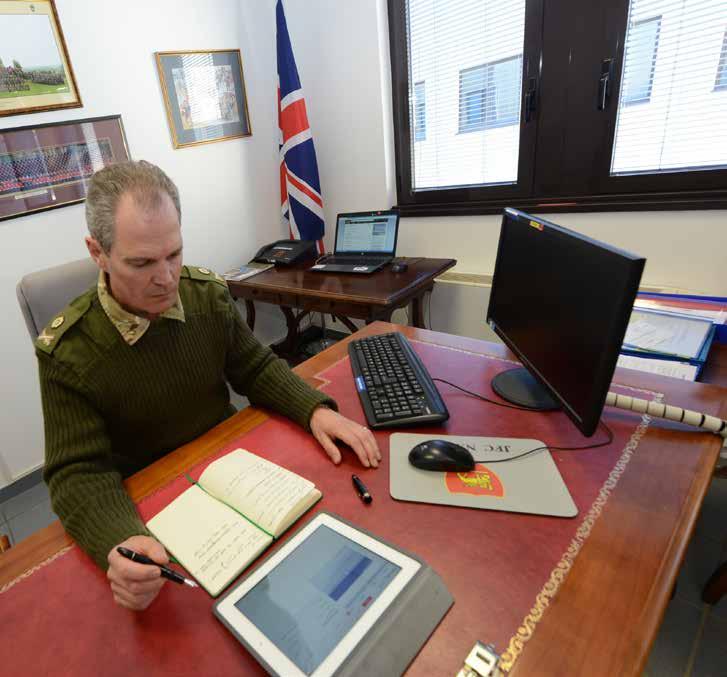
As I write, my nearly 3 years as Deputy Commander of NRDC-ITA is drawing inexorably to a close. It has been a rewarding, fulfilling and enjoyable tour of duty, and a privilege to work alongside the servicemen and women from the many NATO nations who constitute the staff of this excellent Headquarters. Lexi and I, together with our 3 daughters, will look back on this extraordinary period of our lives with great fondness, and leave enriched by the many experiences - military and otherwise - that we have been lucky enough to enjoy here in Italy.
The Headquarters has been on quite a ‘journey’ since my arrival in the summer of 2013. At that point the Commander and many of the staff were still deployed in Kabul, leaving me and the Chief of Staff to focus on what was coming next for us all. What it meant to be a ‘Joint Task Force for Small Joint Operations with a Land focus’ was something of a mystery to everyone, for there was no doctrine setting out what we should do, or how we should be configured. Some were of the view that we needed simply to apply the joint doctrine written for the genuinely joint HQs in Brunssum and
Naples. But it was clear to us that that would have been to miss the point, for we needed to operate and command concurrently at the operational and tactical levels, which required a new way of thinking and operating, as well as a structure that would support this. And hence we adopted what is now known as the ‘integrated model’ of command, and a 3 pillar structure designed to reflect the central place of ‘influence’ in all that we do, and the critical requirement to coordinate the kinetic and non kinetic tools available to us in order to achieve this influence in the optimal manner. Not everyone was immediately comfortable with this, and the succession of exercises that we deployed on in order to implement this approach were both demanding and challenging. But as some long-winded Englishman once said: ‘the proof of the pudding is in the eating’, and by the time we travelled to Stavanger for our final certification exercise, we had mastered this complex business as well as any HQ in NATO’s Force Structure, and have reason to be proud of what, collectively, we achieved. This speaks volumes for the dedication and commitment of the staff, and I thank you all warmly for this.

demanding circumstances. I have no doubt that by the time of the next Certification exercise in 2017 you will have strong views and clear recommendations for the development of doctrine in this respect, and play a critical part in NATO’s continuing transformation.
While the work has been stimulating and engaging, there is much more that makes a posting ‘at the foot of the lakes’ so attractive for the international community. To have La Scala an hour South; Como and Maggiore less than an hour East and West; and a dozen superb ski resorts about two hours North, makes us the envy of our unfortunate colleagues living out their existences in our various national Ministries of Defence. It has not been difficult persuading our daughters and many friends to join us here, whatever the season, and Varese in general - and Caidate in particular - will forever remain a happy memory.
But, as always, it is the people who define one’s existence, and in all of you we have been blessed. Thank you.
So it is with a definite sense of ‘déjà vu’ that we turn our minds to the HQ’s next role as a Land Component Command. Yes, the doctri ne exists for this, but how it should be applied in the era of ‘hybrid warfare’, and following 10 years in which it has become very clear - if it wasn’t already - that the military instrument is but one means by which today’s geo-political crises must be addressed, remains a very good question. I am therefore delighted that the Headquarters is embracing the opportunity to grapple with the practical implications of commanding the Land Component under the most

25th January - NRDC-ITA welcomes a new Chief of Staff.

Major General Giovanni Manione left his duty as Commander of the Italian Army Infantry School in Cesano to take over from Major General Maurizio Boni, former Chief of Staff of NRDC-ITA and now Commander of the Centre of Simulation and Validation of the Italian Army in Civitavecchia.
Major General Giovanni Manione is an Alpini Officer and has already gained vast experience in multinational environments during his previous appointments as the Italian Military Representative to the European Union and on NATO missions abroad.
Major General Manione was born in 1960 and joined the Italian Army in 1979. As well as successfully accomplishing his studies at the Military Academy, he graduated with a doctorate in Strategic Sciences in 1984 after which he started his active career as an infantry (mountain) Lieutenant.
In 1993 he attended the Italian Army War College and the Command and Staff College in 1995 before completing the Italian Joint Defense Staff College in the following year. Maj Gen Manione graduated with a doctorate in International and Diplomatic Sciences in 2005. His appointments have included Commands at Company, Battalion and Regimental level and
staff duties as branch Chief in the Army General Staff (Force Planning) and as the Italian Military Representative to EU (Plans and Policy). Of particular note, with respect to EU Military Capabilities, Maj Gen Manione has been the Italian delegate to the EU Headline Goal Task Force (HTF) where he helped steer the development of the Headline Goal from the beginning of the process until his appointment as HTF chairman in 2002 and subsequently as Officer in charge of Political-Military issues concerning the Italian Delegation until November 2005. He commanded the 3rd Alpini Regiment from November 2005 to October 2007 when he was appointed Director of the Civilian-Military Cell within the EUMS and in December 2009 he was appointed Deputy Director of Crisis Management and Planning Directorate. Maj Gen Manione took over Command of “Julia” Alpini Brigade from July 2011, and from September 2012 until taking up his current pot he Commanded the Italian Army Infantry School and was Inspector of Infantry. Maj Gen Manione participated in NATO operations in Bosnia - Herzegovina as SFOR Chief J2 Plans and Policy (1996-97) and Afghanistan (ISAF) as Italian Battle Group Commander (2007).






The unique story of a brand that has been synonymous with mountains, adventure and open-air since 1870
Once there was an idea. It was 1870 when Cesare Ferrino began industrial-scale production of the formula for waterproofing fabrics that he had discovered, tried and tested and perfected over the years. It was a winning idea.
This marked the start of the Ferrino story. More precisely, the story began in the company’s Turin store at 107 Via Nizza, centre of production for waxed cloths, tarpaulins, and army tents as well as the only place to go if you were looking for avant-garde technology.
As well as the outdoor industry, for some years Ferrino has been
making progress in new specialist fields. With a line of products specially developed for emergency situations, today Ferrino is a supplier to the United Nations, Caritas, Red Cross, Italian Civil Protection, National Mountain Rescue Corps and all the major humanitarian aid organisations.
At the same time, it is also expanding quickly into the armed forces equipment industry. In fact, Ferrino supplies the Italian, French and English Defence Ministries, for which it develops and manufactures special equipment made directly to customer request.
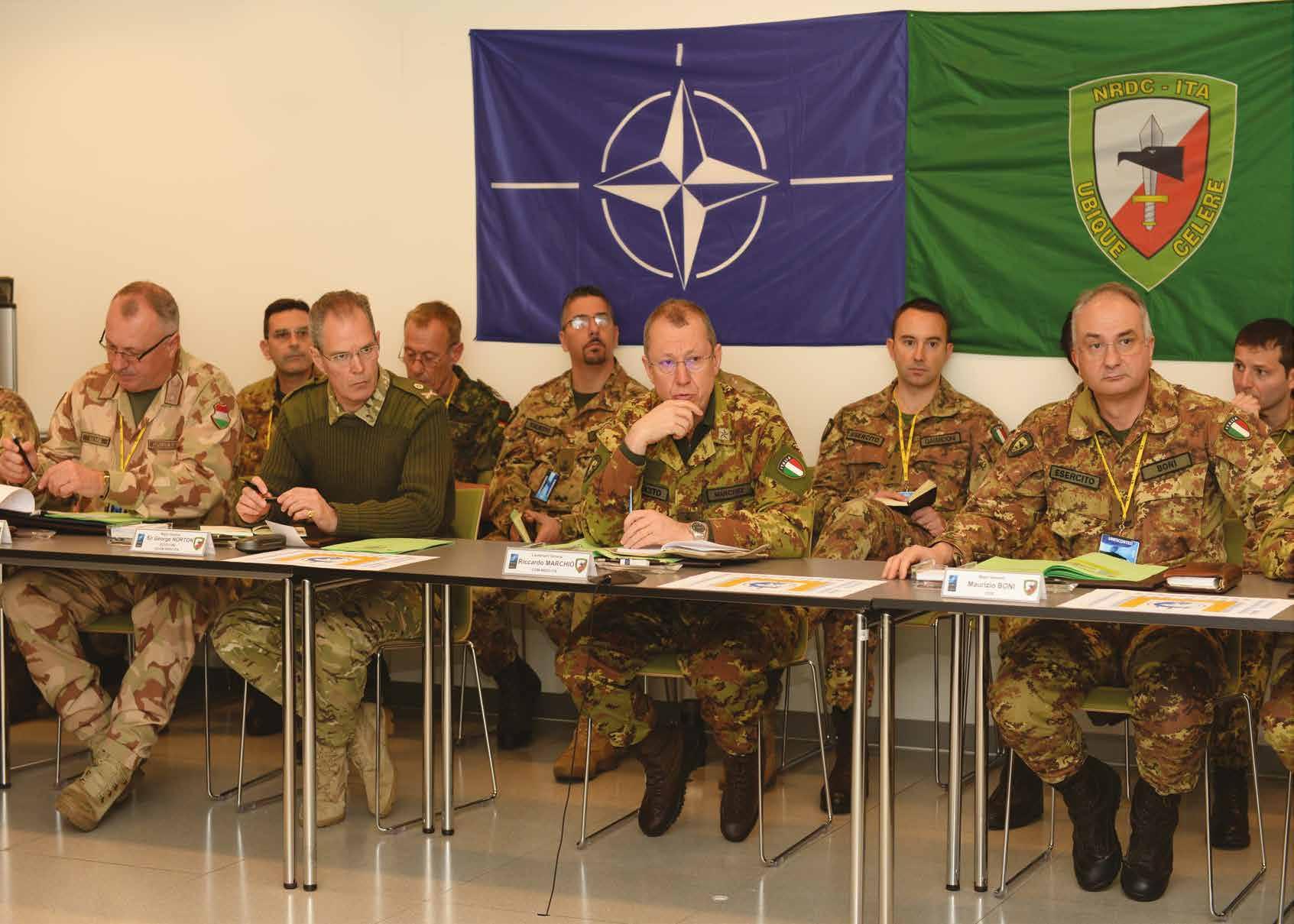


Maj. GBR (A) Steve Caldwell. Assigned to NRDC-ITA May 2014, Staff Officer responsible for co-ordination of Branch planning and activities within Influence Division
“Changing minds has become more important than destroying Armies”
Col (Retd) Thomas X Hannes USMC.
In order to meet the challenge of Operations in the complex modern environment, military effect is only fully achieved with activity in the information and social domains. HQ NRDC-ITA has responded to this requirement of modern conflict with the Influence Pillar. This focuses on the Information Environment in a way that shapes, supports and enhances operations in modern conflict. To explain better how this works, it is necessary to describe a bit about what makes the modern conflict environment different to the old one. In a word: information. We are more connected than our parents were by communication technology. Only half of the world population had access to a telephone 25 years ago. Now more people in the world own a mobile phone than a toothbrush, and more people in India have access to mobile phones than
toilets. We are also more informed by multiple information sources. Advances in technology have made all forms of media easier to produce, distribute and consume. Take note that to be informed does not necessarily mean to be aware of the facts, but a version of them. How people are informed is again very different to even 10 years ago. The advent of social media and the interconnection of the audiences, with the views of others has created a dynamic information environment that is effectively global. From 16 million users in 1995, the internet is now as-

sessed to be used by over 3000 million people – 42% of the global population. We can assume that this 42% is the most relevant 42% to international relations and conflict. This trend in proliferation is only set to continue. Smartphones are spreading faster than any technology in human history, with smartphone activations outnumbering childbirths by 3:1. This technology and the level of access to it, means that people are generating media as much as consuming it, regardless of their motivation, expertise or awareness. The military cannot be in ignorance of how the world has changed. Any military effort is made to achieve a change of will, to act in accordance with the wishes of those conducting the military effort. Military physical force is the method through which that change of will is traditionally achieved. The new information environment however, affords other avenues to affect that will. As leaders depend on the perceptions of their followers, they depend therefore upon con-

ditions within the information environment, as they are seen by most through this. This means a change in the approach of military operations. While we will still deal in objectives, effects and targets; we now need to add audiences to those considerations. As military actions are ultimately conducted to have an effect on will and perceptions, how audiences see our military action, and those we are conducting it against, will be instrumental in achieving the desired change in will
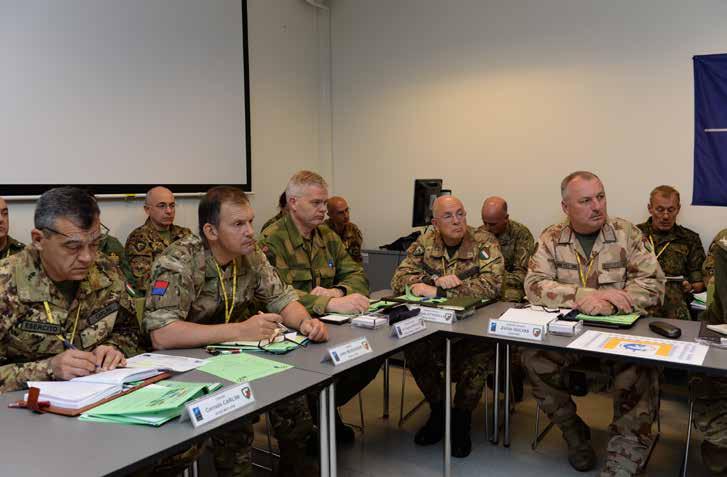 Brigadier General Zoltan Gulyas, Influence Division Commader (third from left) and his Staff
Brigadier General Zoltan Gulyas, Influence Division Commader (third from left) and his Staff
While planning, coordinating and executing physical manoeuvre operations is still a full time job, this is now done while also conducting the essential manoeuvre in the information environment. The three pillar structure allows NRDC-ITA to do this by having the Influence Pillar to focus on the Information Environment, keeping close coordination with the physical manoeuvre being conducted by the Operations Pillar. Within the Influence Pillar, the branches are grouped to afford the best approach to the modern environment. Joint Fires along with Public Affairs/Media Operations and Information Operations ensures that our ‘kinetic action’ – our use of firepower – is not only understood in the right way by the audience, but sends the right message to those for whom it is intended. The inclusion of Stability Police under the Provost Marshal, Civilian Military Interaction and Security Force Assistance allows Influence to track and shape the positive developments that NRDC-ITA is making within the Area of Operations, and use this to effect in the Information Environment too.
HQ NRDC-ITA’s journey to NATO accreditation as a JTF HQ saw a rapid development of this structure and its respective capability in just over a year. Drawing on lessons from 2014, the Influence Pillar developed robust and dynamic practices to meet the challenges of operating in this new environment. The Division was then put into action during the NATO accreditation Exercise - TRIDENT JAGUAR – held in Stavanger during April 2015. This scenario posed a complex, contested and fragile Information Environment during a Non-Article 5 internal state conflict within the country of ‘Arnland’. The problems posed here were challenging
and required NRDC-ITA to operate in a hostile Information Environment with a challenge to support an unpopular government against a popular rebellion within a complicated strategic setting. This highly challenging and complex scenario showed the ability of HQ NRDC-ITA to not only meet the challenges of the modern Information Environment within complex political situations, but to confidently manoeuvre to gain decisive advantage within it. In doing all this, HQ NRDC-ITA has now reached the limit of where existing NATO doctrine can actually support our manoeuvre in the Information Environment. HQ NRDC-ITA is already manoeuvring in uncharted territory in respect to doctrine. However, this is being done in a forward-thinking way that seeks to apply the lessons of the past with the trends of the future to remain at the forefront of military conceptual development. This ensures that the HQ is ready to meet the challenge of the modern environment, thus providing NATO with a versatile Land Command Capability, capable of operating in multiple domains, making it fit for current and future operations.

Exercise Trident Jaguar 15, a moment of the Communication Board meeting



Nowadays technology is embedded in daily life, in a way that we cannot even fully understand. For example, it is unusual to find a lost driver looking at a map, in the same way it is becoming unusual to see a Commander making decisions in front of a printed map. It is impossible to think of military operations being performed without the aid of a myriad of Information Technology tools. To enable a Commander to make critical decisions it is imperative he has access to all the information. The so-called Common Operational Picture, from a tactical to operational point of view, can be represented using traditional tools. However it is practically impossible to build a snapshot of all the information the Commander requires in a JTF Operational Area. Going back to the lost driver example, we can imagine that he will eventually find the way home, but it would be extremely hard for him to give his wife a realistic arrival time with the actual traffic conditions or find an alternative route in case of problems. With all this data coming from different sources, the new challenge becomes the organization and filtering the vast magnitude of information. As with the World Wide Web, if in the past it was hard to find data, now the challenge is to find the relevant data. If we do not
ask the correct questions, we find too many answers to identify the one relevant to us. In other words, if our lost driver’s brand new navigation system screen is crowded with too many instructions, points of interest and irrelevant off-road tracks, he will be even more confused.
That is why the main focus on COP management tools is the grouping and filtering of information. Due to this constant evolving of the Situational Picture, the role of a team of specialized COP Managers is becoming more and more important.
The NATO Communication and Information Agency (NCIA) plays a very important role in the development of software that is used in all NATO operations and exercises. Some Common Interest Services (also known as Functional Area Services) have become indispensable tools for the staff, like Integrated Command and Control system for Air Operations (ICC), Maritime Command and Control Information System (MCCIS) for the Maritime components, and Joint Operational Center Watch (JOCWatch) for the Significant Events. NATO Rapid Deployable Corps – Italy (NRDC-ITA) has always tried to make good use of these tools and even to find parallel solutions to the ones offered by NCI Agency. This is why the Headquarters decided to adopt nationally designed systems SIACCON 2 and C2I in the last
two major exercises, Exercise Eagle Joker 14, the National Certification of Joint Task Force Full Operational Capability included Exercise TRIDENT JAGUAR 15, our JTF validation. This choice required hard work from both NRDC-ITA and SELEX, an Italian Company belonging to Finmeccanica Group that produces these tools in close cooperation with Italian Defence General Staff.
SIACCON 2 is a Land Command and Control System already in use by Italian Army Units. It has a great potential and is fully interoperable with other NATO tools as it has been developed using the main standards. As the Staff become more familiar with it, its use within the Headquarters has now become part of the daily routine. The other tool that played a major role during Exercise Eagle 14 Joker and Trident Jaguar 15 is C2I. This is the Headquarters COP tool when deployed as Joint Task Force, which unlike most FASs runs within a Web Browser, requiring less specialized equipment. Due to this during Exercise Trident Jaguar 15 it was distributed to the entire HQ and subordinate HQs (e.g. NSHQ deployed in the Baltic area) for the use as the COP, overcoming the challenges related to the installation in the Virtual Network Architecture of the Joint Warfare Centre in Stavanger (Norway). With C2I being interoperable with all major NATO tools it is ready to receive any source of information, and then to display this information to all staff as a complete Common Operational Picture in a simple to view format. This simple format however, can be further expanded with the use of filters to display much more in depth information, providing a complete operational picture and providing full Situational Awareness. NRDC–ITA J3 Operations Branch, in co-
operation with Information Management

Cell, had organized several classes before the last major exercises, in order to train the entire HQ on the use of the Information Technology tools. Some classes have been set up for the key elements of the external Units, before and during the exercises. The results achieved during Trident Jaguar 15 where so impressive that both NRDC-ITA and SELEX personnel where contacted by several guests who have expressed their interest in the systems used. We can say that NRDC-ITA found its navigation system that is taking us to the final destination in the right way. Of course we can also say that this is only a 1st generation navigation system and the future is made of information superiority, full systems interoperability and apps/packages concept, the same used in modern smartphones. To achieve that, other than using state-of-the-art Information Technology tools, the key is Interoperability. NATO runs two main exercises every year, Steadfast Cobalt and Coalition Warrior Interoperability (CWIX) with the main target to improve interoperability of Functional Area Services developed by NCI Agency and National Systems. If in the past, military technology was ahead in developing new tools that were then adapted for civilian use, nowadays technology developed by civilian runs very fast and we cannot risk being left behind. More and more resources need to be allocated in the development of Command and Control Systems to be abreast of the current situation and also face the challenges that the future will no doubt bring.

Lt.Col. ITA (A) Alfonso Fornabaio. Assigned to NRDC-ITA in 2012, Staff Officer within the Joint Logistic Support Group (JLSG), responsible for developing air and multi-modal transportation planning.

Lt.Col. ITA (A) Giuseppe Mendicino. Assigned to NRDC – ITA in 2011, Staff Officer within the Joint Logistic Support Group (JLSG), responsible for liaison and coordination with Intelligence Branch
The Joint Logistic Support Group (JLSG) of NRDC-ITA is likely to soon be given the additional responsibility to operate as the expeditionary (or tactical) logistic formation to the Theatre of Operations. This will occur when NRDC-ITA fulfils the role of Land Component Command for a Major Joint Operation led by a Joint Force Command (Naples or Brunssum), and NRDC-ITA JLSG will act as the deployed JLSG under the (Standing) JLSG from the Supreme Headquarters Allied Powers Europe (SHAPE).
This gives rise to the necessity for our JLSG to focus, during planning and execution phases, not only on the classic and current intelligence about threats and opportunities, but also on the theatre logistics intelligence.
Logistics Intelligence
Logistics Intelligence can be defined, according
to Joint Force Command – Naples’ “JLSG Handbook”, as the analyzed information required by the logisticians to plan and execute the operational and tactical logistic support to the force. Accurate and thorough logistics intelligence assessments conducted well in advance of the strategic deployment can minimize potential problems during deployment and reduce the cost of moving forces, supplies and equipment to the Joint Operational Area.
“Land Forces Logistic Doctrine” guides logisticians to run their estimates considering geography, supply, facilities, services, transportation, maintenance, medical, ge-

neral skills and political situation of the Host Nation(s). Therefore elements to be considered in a logistics intelligence assessment may include, but are not limited to:
1. Host Nation support or International Community available in the JOA;
2. Situation regarding Lines of Communication;
3. Environmental, geographical, climatic and topographical factors that may affect logistics operations, including alteration consumption factors;
4. Capabilities of potential ports of debarkation and facilities to support reception, staging and sustainment operations;
5. Medical issues.
The classic intelligence doctrine in AJP 2.1 (currently under revision), established the necessity, at the tactical level, to prepare the so-called Intelligence Preparation of the Battlefield (IPB) as a preparatory study for any decision making process and situational awareness. The IPB included any relevant information concerning the environment and the threat, but for a limited portion of terrain, normally the area assigned up to Brigade level. At the Operational level, the correspondent product is the Joint Intelligence Preparation of the Battlefield (JIPB), the main purpose of which is to support the campaign planning and decision making.

However, as a consequence of the broader Comprehensive Approach (CA), the Comprehensive Operations Planning Directive (COPD) is already requiring the preparation of a larger initial intelligence study. This is in order to cover, not only the traditional elements already foreseen in a JIPB (Battle Space Evaluation, Threat Evaluation and Threat Integration), but also any other relevant aspect of the Political, Military, Economic, Social, Information or Infrastructure (PMESII) landscape. This new product is the Comprehensive Preparation of the Operational Environment (CPOE) and it is a responsibility of the Knowledge Directorate (KD) or equivalent organization. For the JLSG’s point of view the introduction of the CPOE represented a step towards its need for knowledge. This is because it includes all the necessary comprehensive basic intelligence aspects that refer to logistics such as civil logistic infrastructure, effect of seasonal climatic variations, civil capabilities, existing in-transit agreements, existing Host-nation Agreements (HA), Available Strategic Lift (STRATLIFT) as well as the presence of missions conducted by other International Organizations (i.e. UN, EU, AU etc.) and their logistic activities and plans. With the development of the new Standing JLSG (SJLSG) HQ concept, the CPOE production will be facilitated by the presence of NATO Force Integration Units (NFIUs) inside six Host Nations (Baltic Republics, Poland, Romania and Bulgaria) with permanent logistic HQs destined to support any operation in their national area of responsibility. The Log Planner will therefore develop an initial systems perspective of the Area of Interest (AOI) by identifying basic logistic characteristics related to the PMESII environment and how they relate within the operational environment.
The JLSG operates by managing all classes of logistic materiel using transport, man18

power and contracts. The additional infra structure and resources of the host Nation(s) are always finite - and therefore should not be overburdened because they are relied upon for the needs of the population.
Unfortunately Operational Theaters are usually characterized by scarceness of resources, limited access to essential infrastructure or competition among the various logistics actors operating in the area. These factors have implications yet to be fully captured as we will demonstrate below.
The Comprehensive Preparation of the Operational Environment (CPOE) should reflect Humanitarian Logistics stakeholders already operating in/for the operational Area of Interest of the NATO Force, including their values, principles and mandates. International Humanitarian Organizations are major logistics operators capable to generate a massive operational supply chain downstream into the operational space in favor of local beneficiaries that often will be millions of individuals. This may be considerably bigger than a military supply chain, which would be highly specialized and tailored to exclusively sustain its force. Therefore it is evident that, in order to provide a more sound and comprehensive estimate of the descending operational implications of a humanitarian and military coexistence within a common operational domain, it is important to render an updated overview of the humanitarian logistics response organization and metho-
dology that has been implemented since the 2005 Humanitarian Reform of UN and Major international NGOs (e.g. CARE, VISION, ICRC, IOM, RED CRESCENT, MSF etc.).
In operations nowadays, a robust understanding of the International mechanism in providing humanitarian assistance to the affected population is critical from several operational standpoints:
-any military force deployed in a crisis area will most probably operate in close contact with multiple IOs and international NGOs already present in the same area;
-some civilian agencies are in reality major logistic brokers able to plan and execute complex humanitarian efforts mainly via contractual means, provided by huge international donors, who potentially can exert significant influence through their political stakeholders back at UN global level. Achieving a deeper understanding of major humanitarian logistics brokers could potentially result into an opportunity to improve the JLSG’s ability to perform.
The Humanitarian Reform in Brief, the Cluster Approach and the Logistics Cluster
tified weaknesses in humanitarian response, the UN Emergency Response Coordinator, through the Office for the Co-ordination of Humanitarian Aid (OCHA), introduced the recommendations of the Humanitarian Response Review by setting out an Agenda for reform in September 2005. The Humanitarian Reform seeks to improve the effectiveness of humanitarian response by ensuring greater predictability, accountability and partnership. The reform was rapidly developed along three lines, known as the three pillars of the reform:
1. Development of clusters at global and national levels;
2. Strengthening of the role of the Humanitarian Coordinator at the field (Theatre) level;
3. Modification of some aspects of the funding mechanism.
A Cluster is a group of organizations working together on specific topics to improve humanitarian response. In essence a cluster is a “sectoral group” (or in some cases, “working group”, “thematic group” or “task force”). The Inter-Agency Standing Committee (IASC) designated the World Food Program (WFP) as the lead of the Logistics Cluster at Global Level. In practice, this means that in most cases WFP will also be the lead at country level. In exceptional circumstances another organization may be appointed as Cluster Lead at country level.
The field level cluster is supported by WFP through the Global Logistics Cluster Sup-
port Cell (GLCSC). The GLCSC consists of a dedicated, multi-skilled, diverse group of logisticians drawn from various humanitarian organizations (UN agencies, NGOs and government organization) to implement the Global Logistics Cluster work plan. The GLCSC is situated in the Logistics Division of the World Food Program in Rome.
The GLCSC has the role to back-stopping field activations, to support preparedness and capacity building and to facilitate joint ventures. The GLCSC does exist not define nor control the global logistics strategy of other organisations, but rather exists to support logistics cluster field operations and the needs identified by the participants of the Global Logistic Clusters.
The decision to activate a Logistic Cluster at field level lies primarily in the field. The Humanitarian Coordinator, in close consultation with the Humanitarian Country Team (HCT), is responsible for securing agreement on the establishment of appropriate sectors and sectoral groups, and for the designation of sector leads. This decision should be based on a thorough assessment of needs and gaps, as well on a mapping of response capacities including those of the host government, local authorities, local civil society, international humanitarian organizations and other actors, as appropriate.
Because of the ad hoc and unpredictable nature of many international responses to emergencies, the international community (UN agencies, international organisations and NGOs) reviewed past emergency responses and identified consistent gaps. Because of these iden-

If the activation of a Logistics Cluster is foreseen, a Logistic Response Team (LRT) is sent to the field for assessment, to make recommendations to the Humanitarian Coordinator (HC)/Response Coordinator (RC) on whether or not the activation of a Logistic Cluster is needed and what logistics support might be needed in country. If activated, the LRT usually initiates the Logistics Cluster operations. The LRT can be comprised of members from different organizations, including staff from the GLCSC in Rome. Logistics Cluster operations may vary in nature and scale depending on the needs of each parti-
cular country. They may range from basic coordination and information management services (such as infrastructure assessment, port/airport coordination, transporters & rates, customs, equipment supplier information, mapping and geographic information system) to those involving common air, ocean and overland transport and storage (i.e. heavy logistics operations). One of the tools commonly used to provide an overview of a Logistics Cluster operation is the GLCSC Concept of Operation (CONOP): When a Logistics Cluster is present in the Theatre of Operations it is evident that it represents an excellent opportunity for improving the effective logistics intelligence of JLSG.
Once in TO the fly-wheel within the Intel Cycle is to be the JLSG Collection Plan, a living document deriving from the intelligence tasks received from the JFC/JTF HQ coupled with the Priority Information Requirements (PIRs) of COM JLSG.
Effective Intelligence for an “expeditionary” JLSG HQ
By definition the “expeditionary” JLSG is a tactical mission-tailored HQ operating into the Joint Logistic Support Area (JLSA). Its assigned units, chiefly logistic assets, are agreed, in terms of quantity and sizes, upon evaluation of the tasks. However intelligence assets are not normally allocated among them. In fact the JLSG HQ staff has limited manpower in terms of specialized personnel; an Intelligence staff officer (analyst), a security officer and a non-commissioned officer. The provision of accurate, timely and actionable current intelligence will be fully dependent on the JTF/JFC HQs support, NATO intelligence agencies and by the use of the Request for Information (RFI) system. COM JLSG Priority Information Requirements (PIRs) will be identified amongst the Critical Commander Information Requirements. PIRs will be developed along with many other Specific Information Requirements (SIRs) and lead to the preparation of a Collection Plan containing about 50 / 60 questions for the subordinate units. These can be answered by using open source information as well as the
daily direct contact with the personnel on the ground, hired civilian and military (non-NATO) and Host Nation contacts. Here is just an example of PIRs taken from the most recent JLSG evaluation (Ex Trident Jaguar 15): The Host Nation Support and coordination activity by COM JLSG is covered in the collection for further analysis of JLSG HQ and above JTF/JFC HQs analysts. It should be noted that COM JLSG coordinates logistics above the National level of the NATO force troop contributing nations.
To conclude this article we thought it could be interesting to recall the “Darfur case study”, a real situation occurring ten years ago in Sudan.
In 2006 the African Union (AU) was in charge of the mission in Darfur (African Mission in Sudan – AMIS). Darfur was divided in 8 sectors including a logistic hub at El Fasher and a strategic fuel farm at El Obeid (the latter in Sudan, but outside the administrative boundaries of Darfur). Each sector was sustained from El Fasher by the use of helicopters (MI-8 type). Fuel was a responsibility assigned to a local Sudanese contractor, Petronas. During that summer a convoy of 30 fuel tankers, belonging to Petronas, moved from El Obeid towards El Fasher. The convoy was expected to replenish the logistic hub and then the 8 sector’s helipads. Unfortunately it was attacked on the route and the column was destroyed. The AU consequently asked Petronas to honor the contract and to send another convoy, but Petronas candidly replied that after losing almost 1 million dollars it was not fea21
sible to replace 30 tankers at such short notice (these vehicles are not produced in Africa, but usually imported from other continents). As a consequence the AU ran out of JP-4 fuel and the sectors remained also with limited food rations since pilots were forced now to fly from El Fasher with double the fuel quantity in their tanks, in order to be able to return without re-
the AU engagements with HN and IC stakeholders were evidently poorly supported. History tells us that NATO will not be the unique actor operating “in splendid isolation” in a theatre of operation. An organization such as the UN is undoubtedly, from the logistic perspective, a giant in comparison with the Alliance because of its major influence, or
(1) Why asymmetric are directed against JLSG?
(2) Why conventional threats are directed against JLSG?
(3) Why the JLSG Host Nations Support (HNS) coordination can be disrupted?
(4) Why HNS and/or JLSG operation can be disrupted?
fueling. This meant a loss of almost 50% of the available payload. The standstill lasted 3 months during which the Theatre of Operations was under real pressure; urgent deliveries of fuel were eventually made by the use of flying tankers (707 aircrafts borrowed from NATO or, when available, donors) at unbearable costs.
The AU made an attempt to ask the support of the UN (already operating in South Sudan), but the UN was not available at short notice to cover the gap both for technical reasons (JP-4 fuel once delivered has to be sampled before using it by an official laboratory, the closest was in Kenya) and frictions with the Sudanese authority (Petronas was owner of the fuel farms that is to say that the Sudanese authority would exercise a veto in case the UN had asked to replenish them). A year and a half later the UN had to intervene directly in Darfur.
This story illustrates how the AU Logistics Intelligence had failed to identify a HNS threat against the AMIS logistic Centre of Gravity; the inability of its fuel contractor to replace a convoy. In addition to this,
“weight”. As the JLSG supports the planning phases in a “comprehensive approach”, its Logistics Intelligence has necessarily to focus, using the instruments of firstly the CPOE, and then (with an appropriate Collection Plan and RFIs) on those relevant actors and factors that can impact adversely on the mission at the operational and tactical levels. Intelligence Officer stakeholders are not necessarily there to hinder plans, but their presence and activity in the theatre, if ignored, can have a huge undesired impact on military operations. In fact, these stakeholders have to be perceived as an opportunity for a JLSG: Logistics Intelligence, mainly at Strategic and Operational levels, can help to identify not only the classic threats, but much more the actors that conduct core logistic business for relevant “engagements”. This provides intelligence to COM JLSG regarding International Community and Host nation partners with whom co-operation and co-ordination of effort can greatly assist in our missions.

Lt. Col. GBR (A) Davis. Assigned to NRDC-ITA in 2014, Chief of the J6 Operations. Section, resposible for coordinating and delivering CIS support to the Headquarters
During Exercise EAGLE READY, the Operational Liaison and Reconnaissance Team (OLRT) deployed to Poland to conduct meetings with Host Nation actors and a Command Post recce. Unlike previous exercises when the NATO CIS Support Group (NCISG) provided the deployable CIS support to our OLRT; this time, the CIS Kits held and operated by the 1° Signal Regiment were employed. This was the first occasion when these newly

Col. ITA (A) Carmine Pompa. Signals Corp Officer, Chief of J6 Branch at NRDC-ITA
established and accredited kits were deployed and tested under realistic exercise conditions, and the result was a qualified success. In preparation for the JTF Standby period, J6 and the 1° Signal Regiment had built up a range of CIS capabilities to support the OLRT and the Joint Logistic Reconnaissance Team (JLRT). These capabilities were formed from existing equipment, but tailored to the requirements of the Recce Teams. The Regiment now holds one “Heavy Kit” and four “Light Kits”.

The Heavy Kit is designed to support the core of the OLRT with their higher information flow demands and their requirement to reach back to the Permanent Headquarters (PHQ). One heavy kit deployed to Poland, and provided the primary CIS link between the OLRT and the PHQ. The Light Kits are configured to support smaller recce teams that may be detached from the core of the OLRT or JLRT during a mission. All of these CIS Kits are accredited to provide connectivity to the NATO SECRET network, but in addition, they also provide internet access as well as secure and insecure voice services. The final CIS capability is offline encryption software that can protect files up to NATO RESTRICTED to be sent over the internet. This capability is suited to small staff teams operating with a low profile. This facility was used by the JLRT during the exercise to send recce reports back to the Combined Joint Operations Centre (CJOC), and can be operated by the staff without CIS technicians. For Exercise EAGLE READY, the Heavy and Light Kits were deployed to Poland by a commercial transport company in order to save the cost of air cargo. However, normally, they would be deployed with the OLRT/ JLRT in military or commercial air transport. Both kits are packaged in transportable containers, and do not require mechanical handling equipment. The Heavy Kit includes a military satellite dish, which is the largest single component. In contrast, the Light Kit uses a commercial folding satellite antenna, and is much more agile and easily transportable. While the Heavy Kit supported the OLRT Staff throughout the exercise, the Light Kit was run up and tested by J6 and the Regimental operators to identify and validate its capacity and
capabilities. A total of 6 CIS Technicians deployed to set up and operate the two kits. A number of important lessons were identified from this CIS deployment. The Heavy Kit performed exceptionally well, and met the Information Exchange Requirements of the OLRT Staff and fully supported the information flows between the OLRT and the PHQ. It provided robust connectivity to NATO SECRET and the Internet, and supported: email, web browsing, NS VTCs, LYNC conferences and Polycom conferences.
This was the first occasion when these newly established and accredited kits were deployed and tested under realistic exercise conditions; the result was a qualified success
The results of the Light Kit testing confirmed that the bandwidth from the commercial satellite antenna does limit its functionality. If deployed, it is recommended only to use simple voice services and NATO SECRET emailing without attachments. As part of the ITA MoD project to upgrade NRDC-ITA’s CIS equipment, these OLRT Kits will be progressively replaced by smaller and more capable assets. The first new kit is expected to be delivered in early 2016.
In summary, Exercise EAGLE READY provided an excellent opportunity to test and validate the organic CIS Kits developed by J6 and 1st Signal Regiment to meet the JTF Standby requirement. Thanks to the technical competence, ingenuity and skills of the signallers, these kits performed well and fully supported the staff’s requirements..
24

Maj. GBR (A) Tom Wallis. Assigned to NRDC – ITA in May 2014, Staff Officer within Public Affairs (PA), responsible for developing the PA Plans and Policy and briefing media analysis to the Command group
Supported by the Commander, Lt Gen Riccardo Marciò, NRDC-ITA sent a small but capable team of skiers to the prestigious Campionati Sciistici Truppe Alpina (CaSTA) - Italian Mountain Troops Skiing Championships in January 2016. The competition was held in Sestriere (TO) between 25-29 Jan and was a grand affair with over 1000 competitors. CaSTA involved military personnel from 20 Nations competing in a variety of challenging, athletic and technical ski competitions of different types. The NRDC- ITA team was led and organized by Lt Col Ugo Biasotto. It was made up of 12 athletes from the NRDC HQ and Support Brigade, including two international personnel and two female competitors. The team undertook challenging events consisting of a Nordic (Cross country) sprint relay, Giant Slalom races in 3 different categories, a Nordic 15km ski endurance race and a night-time ski mountaineering race. In each event, the entrants gave impressive performances to ensure respectable results despite some imposing competition from Sochi Winter Olympics medal winners. In addition to more than 1000 competitors, there were at least as many logistic, security and other support staff in
and around Sestriere that enabled CaSTA to take place. This meant an impressive visible military presence in the small town. The CaSTA Mountain Troops Skiing Championships started in 1931 as a race between the regiments of the Alpini Troops. This remains the core element - and the coveted platoon patrol races are the most competitively and seriously contested between the elite mountain troops. CaSTA has now developed to host 20 Nations in five different skiing trophies for various categories. NRDC-ITA entered the International and Inter-Services competition known as the “Friendship Trophy”, and competed alongside ARRC, our sister NRDC from the UK, and an additional 18 other teams representing


a Unit or team from their respective Nation. The NRDC-ITA team deployed to the region the week prior to the competition to dust off their equipment and conduct build-up training. Technical preparation was equally as important as ensuring physical readiness. Despite only limited time, the NRDC-ITA team worked hard to ensure that they were in good shape to take part in the competition. Gen Frederico Bonato, Commander of Italian Alpine Troops, opened the event at a large ceremony in Sestriere. Here, he outlined the principle of Military units competing in competitive yet friendly framework to foster closer ties and collaboration amongst allies. He expressed his pleasure at the organization and large number of units and Nations taking part. The Italian Defence Minister, Mrs Pinotti attended the closing ceremony to further emphasize the importance of the event – An event in which NRDC-ITA came a respectable 13th from 20 teams in their competition.
Commander NRDC-ITA, Lt Gen Riccardo Marchiò who attended CaSTA to support the events and encourage the competitors, said “I absolutely support our involvement of NRDC-ITA in CaSTA and I am pleased with the efforts and competitive spirit of the team. Our participation in a competition of this nature is
beneficial to the headquarters because I have seen our personnel overcome physical and technical challenges in what can be a very difficult environment. Also we are able to collaborate and share experiences with other Military Units to enhance Esprit de Corps.
“Also we are able to collaborate and share experiences with other Military Units to enhance Esprit de Corps.”


Maj. ITA (A) Ottavio Iacangelo. Assigned to NRDC – ITA in 2014, Staff Officer, responsible for the management of logistic movements & transportation
he NRDC-ITA Shooting Club was founded last December in order to promote shooting sports within the HQ and create team building in a friendly environment both at competitive and non-competitive level. The president of the NRDC-ITA Shooting Club is Maj. Iacangelo.
What is the aim of the club?
The aim is to promote safe and secure weapon handling through sports activities to facilitate interaction with the civilian environment through the participation in shooting events. This is done by organizing courses, training sessions and competitions both for Military personnel and their families.
Every member of the NRDC-ITA HQ and affiliated units are eligible for the MWA activities, along with their immediate family members. Also eligible are children over 10 years old that can practice, in the National Shooting Range, with air soft weapons.
It is necessary to have the Italian Gun License to practice those sports?
No. Inside the National Shooting Range it is possible to practice shooting without any license. It is possible to rent weapons and buy ammunition making it open to everyone. Also tho-
se untrained can join courses in order to become familiar with shooting sports. Mrs. Simona CARLINO is the first “Army wife” to join the club and we hope that other wives will follow her.
On Dec 13th, in the Vercelli’s Shooting Range, a representative of the NRDC-ITA Shooting Club took part in the charity event “Fai Centro per la Solidarietà”. The event involved 4 Courses of shooting, where a balance had to be found between speed and precision in order to suceed. With more than 100 shooters taking part, NRDC-ITA shooting club gave a good account of themselves; 3 members of the club were in the top ten, W.O. COFFARO coming 5th, Cpl. PANTANO 8th and Maj. IACANGELO 10th.
Col. CARTA, as the senior NRDC-ITA representative, awarded the winners of the different categories and praised their skills.
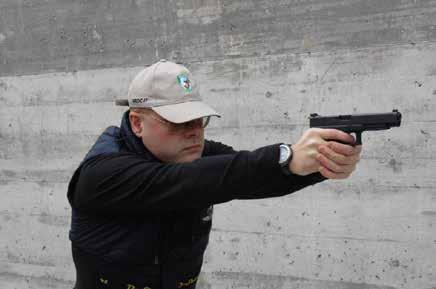
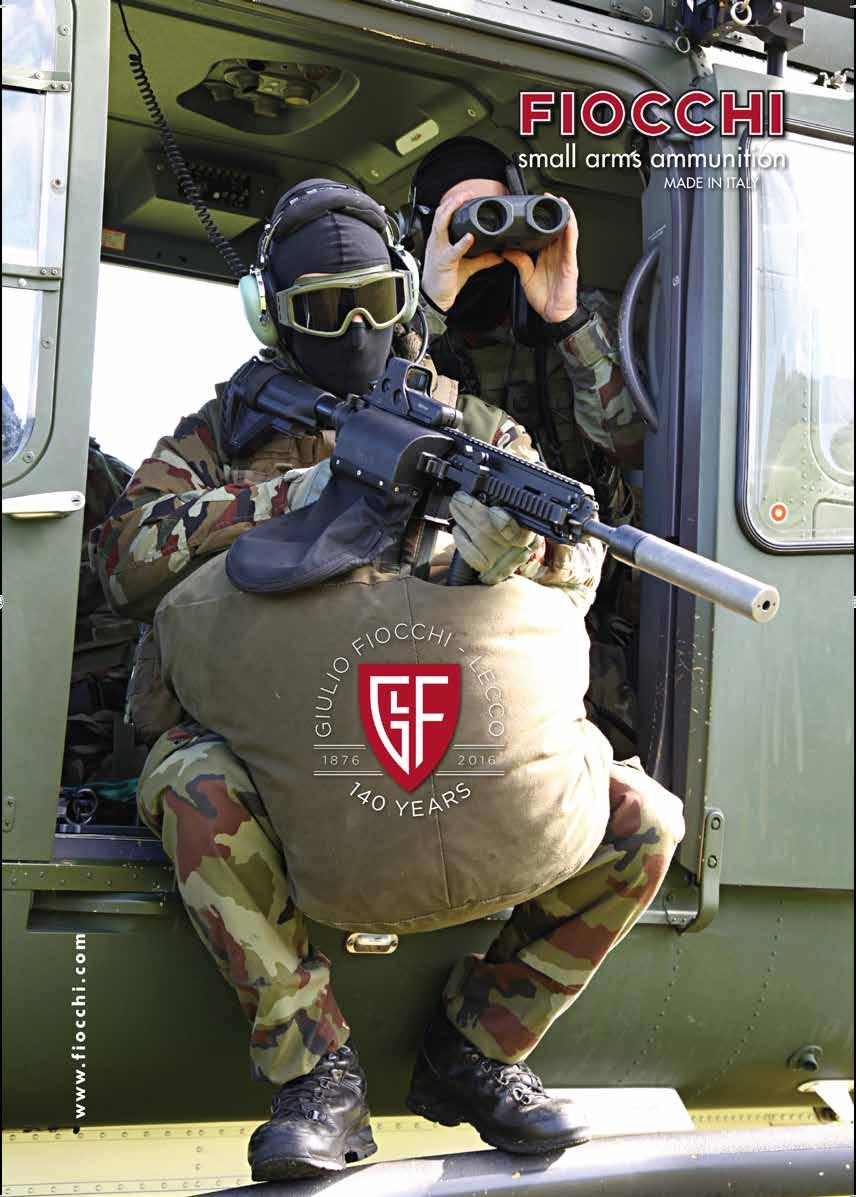

Turin, 4 June 2015......................
The “7th stabilization and reconstruction orientation course” started on 4 June 2015 at the Post Conflict Operations Study Centre (PCOSC) in Turin. The course is held in English and is open to military and civilian personnel, both from Italy and foreign countries.
28 Students joined the course, 13 of whom hail from overseas countries. In two and half weeks the course provides a sound knowledge of stabilization and reconstruction Operations, and puts the students in a position to appreciate the importance of a cooperative attitude, together with a collaborative approach in dealing with the management of crises. This goal is pursued throughout the course by lectures provided by a group of distinguished scholars, coming from both the military and academic environments. Each lecture is followed by time for questions and answers, which gives the opportunity to focus on key aspects of the studies. This high value course is attended both by university students and military personnel, a good example of the Italian army’s leading position in the area of education.
On June 10th, Col Antonio Di Gregorio, from
“The role of NATO in S&R based on the new strategic concept”...
NRDC-ITA gave a presentation on the subject of co-operation between PCOSC and NRDC-ITA, which dates back to the signature of a specific Memorandum of Understanding (MoU) in 2011. This MoU provides, amongst other things, the possibility to exchange subject matter experts and provide mutual support during the conduct of specific activities in the field of Post-Conflict stabilization.



The NRDC-ITA Women’s International Club (NIWIC) has been the protagonist of the 2015 Charity Christmas Bazaar, a fundraising event held to benefit a local charity. This year, Caritas, a voluntary service-based charity association, was chosen. It helps those in need, both in Italy and around the world.
On 3rd December 2015, at “Ugo Mara” barracks Non Commissioned Officers’ Club, members of NIWIC from the 12 nationalities at NRDC-ITA prepared culinary delights from their Country, providing guests the opportunity to taste various specialties.
Lt. Gen. Riccardo MARCHIO’ met the Caritas delegation on 4th February, congratulating them for the high value contribution they offer in supporting the poor and oppressed people in the world to improve their lives.
NIWIC is a recognized voluntary membership association within the NRDC Italy Morale & Welfare program. Every spouse or partner can be a member, as well as any female personnel serving at NRDC-ITA. NIWIC routinely organizes several activities and multinational events in order to bring together the various nationalities involved in NRDC-ITA by fostering good relationships and mutual understanding.
Examples of NIWIC activities include fund-raisers for charitable purposes (such as the 2015 Christmas Charity), Italian and English conversational classes, International Coffee mornings, cultural trips, cooking demonstrations, visits to art galleries, museums, villas, gardens, outlet centers and local markets.
 By Lt. Col. ITA (A) Paolo Rizzo. Assigned to NRDC – ITA in 2010, Chief of section inside the Influence
By Lt. Col. ITA (A) Paolo Rizzo. Assigned to NRDC – ITA in 2010, Chief of section inside the Influence
Italian language courses are aimed at NRDC-ITA foreign personnel to let them better integrate with the local community. Courses started on the 11th February in the presence of NRDC COM, DCOM, COS and DCOS INFLUENCE and will end on the 30th June 2016. During his short speech to attendees, NRDC-COM expressed his satisfaction for the great interest that his foreign Staff have demonstrated for the Italian language, considering that 60% of them are attending it. Attendees are divided in two groups, beginners and intermediate. Lessons for
each course are held twice a week, on Tuesday and Thursday, for a total of 3 hours. Course director, Lt Col RIZZO Paolo (INFL DIV - JFIRES), will support all students in this common effort that has the final goal of allowing them to understand and speak the bacics in the Italian language. This is why a special synthesis grammar book was prepared by him to facilitate and simplify attendees’ learning. This course represents just a small part of the opportunities to share the Italian culture, and is why each lesson is structured over two different periods: one for grammar and the other taking care of the “rea-
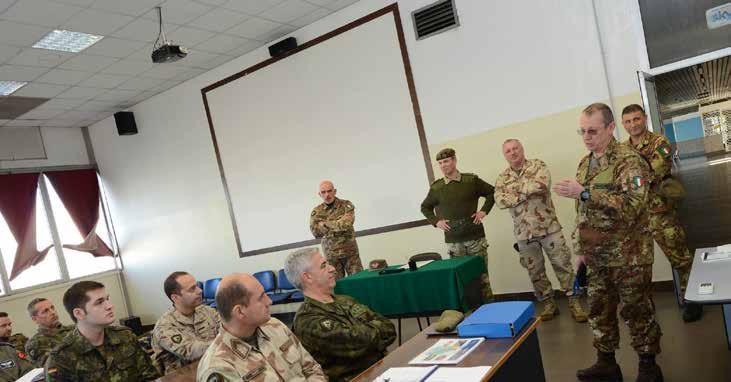
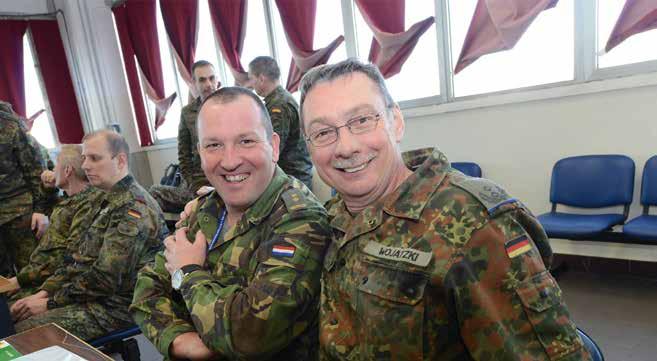
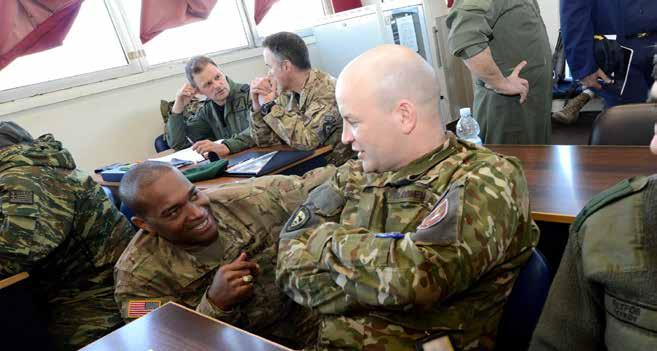
ding” and “speaking” components through the study of major Italian Geographical Regions. In additioin, “listening” exercises are carried out using educational CDs of famous Italian singers like Eros Ramazzotti and Laura Pausini. “I will try to make it as easy as I can and not too boring”, siad Lt Col Rizzo, as he outlined his intent during his introductory words. He said that he hopes his lessons will be great, not just for developing language and cultural knowledge, but also “an occasion for everyone to better know and bond with each other”.
Lt Col RIZZO will be also running English lessons for Italians after Easter. To all those taking part on the language training at NRDC-ITA, we very much hope you enjoy the course!
Visit of Lt. Gen. Salvatore Farina- Chairman of the Steering Commitee for the Implementation of the White Paper for the Italian Defence

15th January - At the “Ugo MARA” barracks, Lt. Gen. Riccardo Marchiò received the visit of Lt. Gen. Salvatore Farina, Chairman of the Steering Committee for the implementation of the White Paper for the Italian Defence. Lt. Gen. Farina was welcomed by the NRDC-ITA Commander, Lt Gen. Riccardo Marchiò, and during his visit was updated on the development of the activities that will bring NRDC-ITA towards the future objectives .
NRDC-ITA Commander received the visit of NRDC-GR Commander
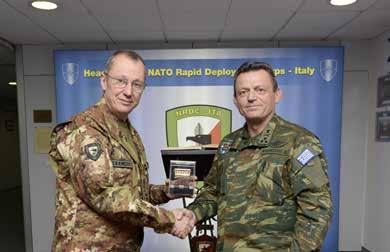
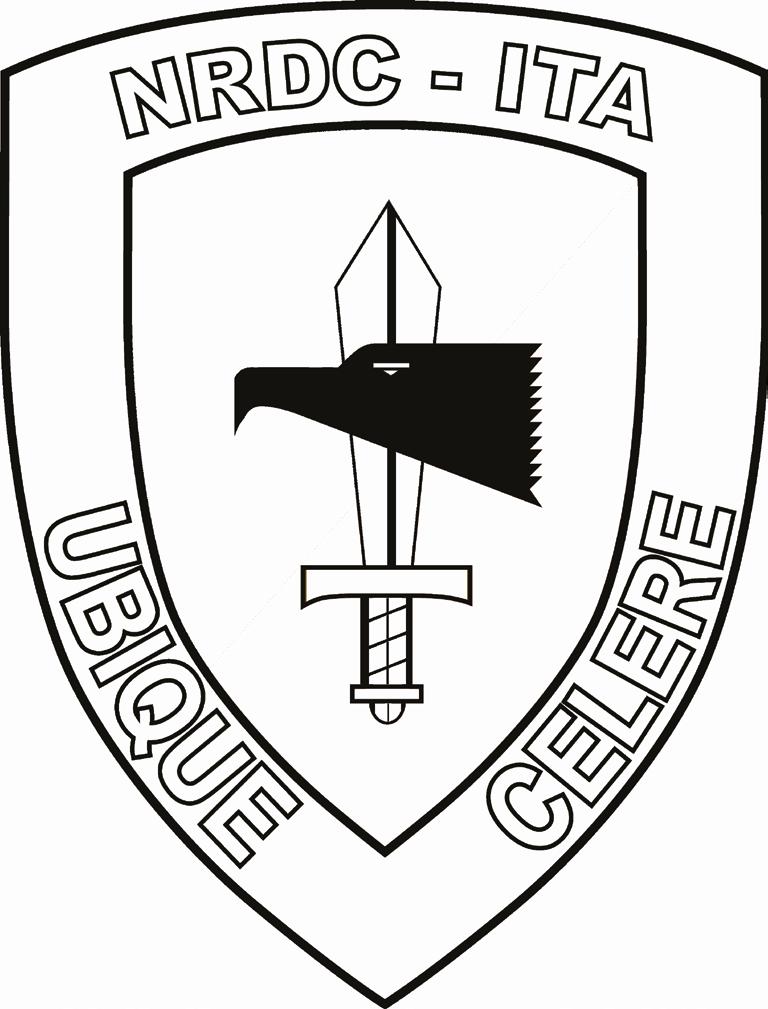
Lt Gen. Riccardo Marchiò received the Commander of the Italian Army Validation and Simulation Centre Maj. Gen.
Maurizio Boni

11th February - At the “Ugo MARA” barracks NRDC-ITA Commander, Lieutenant General Riccardo Marchiò received the visit of Major General Maurizio Boni, former NRDC-ITA Chief of Staff and now Commander of the Italian Army Centre of Simulation and Validation, in Civitavecchia. After being welcomed by NRDC-ITA Commander, General Boni had the chance to meet his “old Staff”. Later in the visit he has been also updated on the development of the current activities of the Headquarters and on the future challenges that will keep NRDC-ITA as a Centre of Excellencefor the Italian Army and for NATO.
4th of February - The Commander of the NATO Rapid Deployable Corps Italy, Lieutenant General Riccardo Marchiò, received the visit of Lieutenant General Ilias Leontaris, Commander of NRDC Greece, one of the NRDC-ITA’s sister Headquarters. During the visit General Leontaris has been briefed on the development of the most recent activities of the “Ugo Mara” barracks. After a videoteleconference with the NATO Allied Land Command and the meeting with his fellow countrymen and women serving at NRDC – ITA, General Leontaris met all the Senior National Representatives of the Headquarters and signed the traditional Roll of Honour.

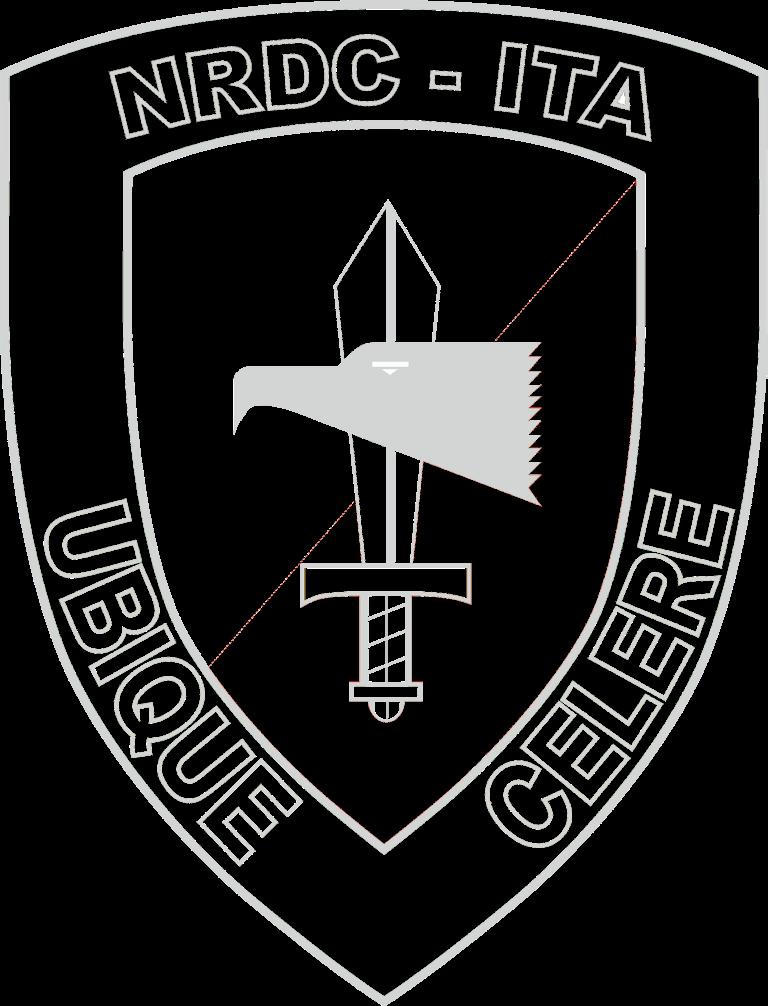
17th February - The NATO Rapid Deployable Corps - Italy hosted His Excellency Peter McGovern, the Ambassador of Canada. The diplomat was received at the “Ugo Mara” Barracks in Solbiate Olona by the Deputy Commander of NRDC-ITA Major General Sir George NORTON, instead of the Commander, engaged in an institutional visit to NRDC Greece. After a meeting with the representatives of the 12 contributing Nations of the Headquarters, the Ambassador attended a briefing held by Major General Giovanni Manione, NRDC-ITA Chief of Staff, during which he has been updated on the development of the current activities of NRDC-ITA and on the challenges that have followed the recent achievement of the Joint Capability. During his visit Ambassador McGovern has expressed the will of his Nation to join the other 12 Countries already working at the “Ugo Mara” barracks, confirming that NRDC-ITA is constantly seen as an international center of excellence for the planning and conduction of NATO or EU-led operations.
